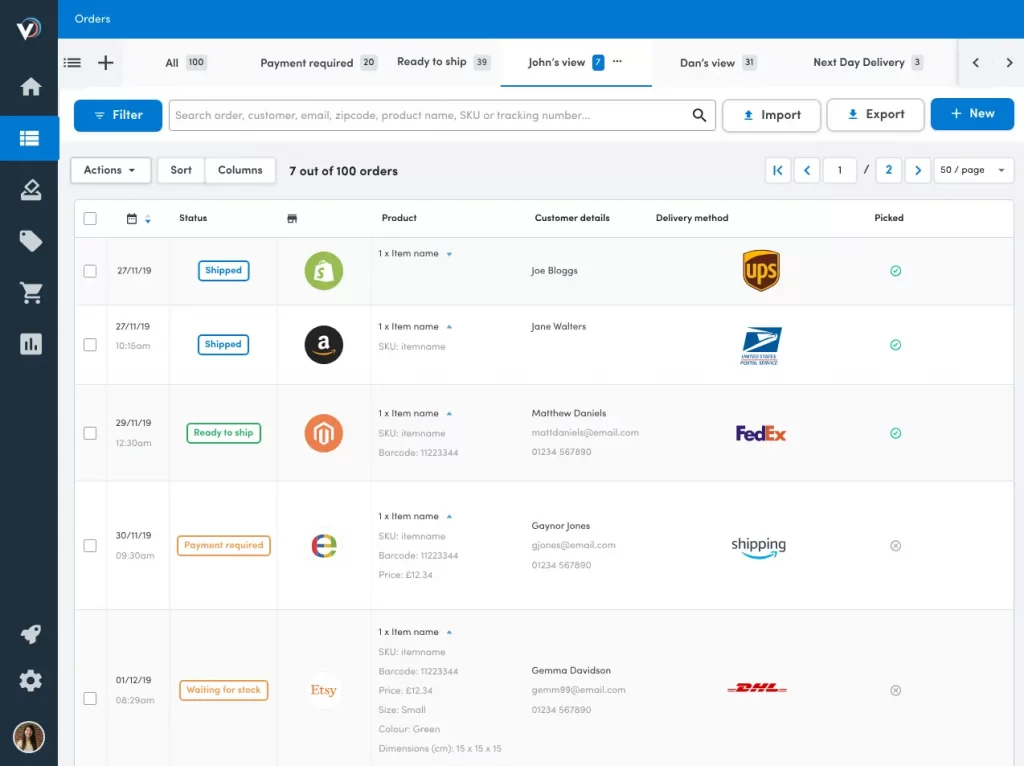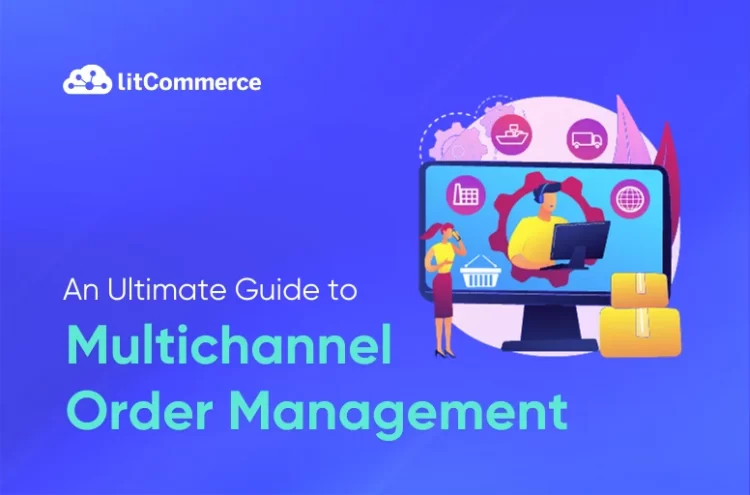In today’s competitive market, businesses often spread their products across multiple platforms to cast a wider net. However, managing orders from all these channels can turn into a tangled mess, leading to errors and frustrated customers. That’s where multichannel order management steps in.
Multichannel order management simply means handling orders from various sales channels through a centralized system, but how does it work? Check this guide to learn more details about:
- What is multichannel order management?
- The challenges of managing multichannel orders
- Key features of multichannel order manager system
- Benefits of multichannel order management platform
Let’s dive right in to explore the best systems for your business management across channels.
Start Multichannel Selling with LitCommerce!
Sell on Amazon, Shopify, eBay, TikTok and more. Sync your inventory and manage all orders in one place – quick and easy.
What Is Multichannel Order Management?
Multichannel order management is like having a central hub for all your sales channels, like your online store, physical stores, and maybe even social media. It connects these different channels under one roof, making it easy to track orders and inventory. This way, you can manage everything in one place, no matter where a customer buys from you.
For example, you sell handmade jewelry online on Etsy and your own website. Without multichannel order management, it’d be like having separate shopping carts for each platform. You’d have to check each one for orders and update stock levels twice! And you can risk accidentally overselling something that’s out of stock. However, a multichannel order manager can avoid those headaches by giving you a single view of all your orders and inventory.
If you just start selling on various platforms or struggle to handle cross-channel, check this multichannel selling guide for tips on streamlining your operation.
The Challenges of Managing Multichannel Orders
Selling on multiple channels lets you reach more customers, no matter how they like to shop. But the more ways you sell, the trickier it can get to handle things after someone buys something.
Tricky inventory management
Managing inventory across different sales channels can be a logistical nightmare if you keep things separate. For example, if you sell on both Amazon and your own website, you need to ensure that a sale on one platform updates the inventory on the other. Without real-time synchronization, you might end up overselling a product on Amazon while it’s already out of stock on your website.
More complexity in order fulfillment processes
Managing a single sales channel is a simple process: spreadsheets, printed labels, and shipping. But with multichannel order management, things get messy. The volume of orders multiplies, and each channel might require different fulfillment methods and separate warehouse locations, making the process much more complicated.
For instance, an order from eBay might need to be shipped internationally with specific documentation, while an order from your brick-and-mortar store’s online system might only need local delivery. This complexity can lead to delays, errors, or wrong shipping, impacting customer satisfaction and increasing the risk of returns.
Training and change management
Every new sales channel brings new tools and processes that your team needs to learn, which requires time and resources for training.
For example, suppose you introduce Shopify as a new sales platform. In that case, your staff must learn how to use Shopify’s backend, process orders, manage customer queries, and integrate it with your existing inventory system. Without effective change management, this transition can disrupt daily operations, making training essential to ensure a smooth adaptation.
Complexity in cross-channel reporting
Generating comprehensive reports that cover all your sales channels can be difficult. For example, if you sell on Etsy, Amazon, and your own website, each platform will have its sales data and analytics. Consolidating this data into a single report to understand overall sales performance, identify best-selling products, and track customer demographics requires sophisticated data integration tools.
As you can see, handling multichannel order management is not easy. That’s why big sellers need a system for efficient and integrated order processing to maintain smooth operations and customer satisfaction across all platforms.
Then, how do you choose the right system? Check the following section to learn all the essential factors to consider when selecting a multichannel order management solution.
Key Features of Multichannel Order Manager System
Don’t get overwhelmed by all the bells and whistles! Multichannel order management systems offer a variety of features, but some are key for any business size or plan. If you do think of investing in software or applications for multiple order management, below are what really matters.
All-in-one eCommerce integrations
A good multichannel order manager system should be like a universal remote for your online sales. It should connect directly to all your selling channels, like your website, marketplaces, and anything else you use. This avoids needing extra tools (third-party integrations) that can cause connection problems and slow you down. So, when you are searching for multichannel order management software, choose the one that works with as many platforms as possible.
If you need a typical example of a multichannel order management tool, take a look at LitCommerce. The tool cuts through the multichannel maze! This OMS connects directly to 20+ selling platforms like Shopify, Amazon, Etsy, and more, eliminating the need for messy third-party integrations. List products, sync inventory, and track orders – all from one central hub. It’s like a universal remote for your online sales, keeping things simple and organized so you can focus on growth.
Streamline your order management with LitCommerce
LitCommerce helps pull all channels’ orders into your eCommerce website. Hence, you can check and fulfill them conveniently. Connect all your channels and manage everything from one hub.
Real-time inventory tracking
Real-time inventory management is a must of any multichannel order management. This means your inventory levels are instantly updated across all your sales channels whenever a change occurs.
For example, if you sell a shirt on your website, the software automatically updates the stock levels on your Amazon and eBay stores. Real-time inventory control also helps you track the costs for each product, giving you an accurate view of your profit margins at both the business and product levels.
Centralized order processing
A centralized order processing system is essential for efficient order management. It acts as the hub, handling every order with precision, no matter where it comes from. This system consolidates orders from various channels into one platform, giving businesses a unified view of their entire order process. From a single dashboard, businesses can manage orders, track inventory, and access detailed customer information easily.
For example, if you use LitCommerce for multichannel order management, you can centralize all order details on one page (such as the number of items ordered, shipping information, and which platform the sale came from). This centralized view allows you to quickly see what needs to be shipped and from where to where. You also don’t need to switch between platforms or spreadsheets to check details since everything is in one place now. This helps minimize the risk of errors during order fulfillment.
Integrated point-of-sale (POS)
Do you ever wish the inventory in your physical store would automatically update with your online sales?
Multichannel order management systems with integrated POS can make this happen. For instance, if you sell a product in your store, the system will immediately update your online inventory to reflect the sale. This way, if someone tries to buy the same item online, they’ll see the correct stock level, preventing overselling and keeping everything in sync.
Multi-location inventory management
If you sell through multiple channels, you probably handle orders and stock across many locations. Then, you need an order management system that tracks stock and sales across warehouses, fulfillment centers, and stores to keep everything accurate.
Multichannel inventory management software with multi-location capability can streamline operations. It directs orders to warehouses with available stock, saving time otherwise spent on manual rerouting. It can also automatically generate purchase orders with suppliers or backorders to restock inventory when levels are low. This integrated approach simplifies management and ensures you can meet customer demands efficiently across all your selling channels and locations.
Workflow automation
Workflow automation is transforming industries, particularly eCommerce and fulfillment. It handles repetitive tasks and frees up time for more personalized attention. By implementing automation across all sales channels, you can create a seamless omnichannel experience for customers. This integration of workflow automation in your order management software minimizes errors and accelerates order processing, ensuring fast delivery and accurate orders for your customers.
Automation features can vary among different order management system software. For example, LitCommerce, designed for multichannel sellers, offers a robust automation feature for automatic order updates. Specifically, when an order is placed on any integrated platform, LitCommerce instantly updates the order details on its main dashboard. Moreover, it also automatically updates the order fulfillment status, indicating whether an order has been shipped or not. You just need to filter the results to check if any items have been missed for shipping, ensuring timely delivery to customers.
Data and reporting
Running a business is all about making decisions. A good multichannel order management system keeps you in the loop by giving you clear and up-to-date reports on everything from all your sales channels. This real-time info helps you make smart choices on the spot. Here are some basic metrics you should include in your sale reports generated by a multichannel order management system:
- Sales by channel
- Order volume
- Order value
- Date range
If you choose LitCommerce, you can access all the above features plus the top-selling items for each channel. This can inspire you to develop new products that cater to the specific demands of each sales channel.
Benefits of Multichannel Order Management Software
Now you know all the challenges of a poor order management system and what you should do to improve it. Are you still considering whether to invest in software or tools for multichannel order management? See the main benefits:
- More efficient processes: Centralizing systems allows for automated and streamlined workflows.
- Accurate inventory data: Real-time updates ensure precise stock tracking and timely replenishment.
- Fewer order errors: Integration reduces risks of overselling, overordering, and fulfillment errors.
- Better scalability: Automated order management systems can effortlessly expand your business.
- Improved customer satisfaction: By reducing errors and improving order accuracy, customers receive their products on time and as expected.
- Data-driven decisions: Use reports to gain valuable insights, identify sales trends and top sellers by channel, and optimize your product offerings for maximum profitability.
To fully utilize your multichannel order management platform, understand your needs and identify the software features that best address them.
4 Best Multichannel Order Management Software
In this section, we will discuss the best multichannel order management software, which makes handling your sales across different platforms a breeze and helps you keep everything running smoothly and efficiently.
1. Veeqo
Veeqo, owned by Amazon, simplifies multichannel order management. It automatically syncs orders from platforms like Amazon, eBay, Etsy, and Shopify and keeps inventory levels accurate across all channels to prevent overselling.
You can easily sort and filter orders by various criteria, such as SKU, customer, or bin location. Additionally, you can customize order views for your entire team or individual users, filtering by warehouse, channel, fraud tags, and more. Veeqo also automates routine tasks like selecting shipping carriers and creating invoices, saving you time and money.
However, Veeqo has a learning curve that might be challenging for smaller businesses or those with limited technical skills. Some users have also reported limitations in reporting.
Veeqo is free to use, making it a good choice for small businesses. For larger businesses needing more advanced features, Veeqo offers a paid “Priority” package for $250 monthly.

2. SkuNexus
SkuNexus provides a unified order view, allowing you to see all orders in one place across all channels and quickly update order statuses. Customer details and history are organized, enabling personalized service based on past orders for a tailored experience.
Plus, SkuNexus seamlessly connects with major shipping providers, automatically finding the best shipping rates and allowing you to track shipments directly from the system. It also keeps inventory levels synced across all channels, adjusting inventory after each sale.
For returns, SkuNexus offers return management that keeps customers informed at every step of the process.
However, SkuNexus may be too complex for small businesses that don’t require many advanced features. SkuNexus is ideal for growing businesses that need flexibility and scalability in managing multiple sales channels.
SkuNexus’ pricing is not listed publicly, so it’s best to contact SkuNexus directly for up-to-date pricing information.
3. Brightpearl
Brightpearl is excellent for handling large order volumes from various channels. It allows you to easily manage order fulfillment by automatically setting simple rules to select the best option for each sales channel. You can also automate everything from picking to shipping, helping you process orders up to 70% faster, according to Brightpearl.
Furthermore, Brightpearl’s integrated POS syncs your online and offline sales and inventory in real time. Therefore, you can keep better control of your finances. The multichannel order management connects seamlessly with popular eCommerce platforms like Shopify and BigCommerce. In this way, it offers real-time updates and smoother operations.
However, while Brightpearl’s pricing isn’t publicly listed, it’s considered expensive for smaller businesses. Plus, its complex features might overwhelm users who don’t need a dedicated IT team.
In short, it’s better suited for fast-growing and more prominent merchants with sales of $1 million or more.

4. Linnworks
Linnworks positions itself as a versatile and user-friendly multichannel order management platform. It supports a wide range of sales channels like Amazon, eBay, and eCommerce platforms, with real-time inventory updates for accuracy. A key feature is its ability to automatically allocate orders to batches that need to ship first, saving you time.
Linnworks lets you create, edit, or cancel orders from one page in seconds. You can also easily sort and filter orders by sales date, order value, shipping provider, or channel source.
However, its advanced reporting and customization options may be less comprehensive compared to other tools.
Linnworks starts at $449 per month and increases based on features and order volume. It is best for mid-sized to large businesses that need a complete multichannel order management system with robust automation features.
Multichannel Order Management – FAQs
Multichannel order management software is a technology solution that centralizes and streamlines the processing, tracking, and fulfillment of orders from various sales channels. These channels include online marketplaces, e-commerce websites, and physical stores. It provides businesses with a unified platform to manage inventory, automate workflows, and gain real-time visibility into their sales and fulfillment operations across multiple channels. Order management involves a series of steps to handle customer orders from start to finish. Here’s how it typically works: Order placement > Order processing > Inventory check > Order Fulfillment > Shipping > Delivery > Post-sale service. An efficient multichannel order management system should automate many of these steps, ensuring accuracy and speed throughout the process. An Order Management System (OMS) handles and tracks orders, inventory, and fulfillment, ensuring smooth operations from when an order is placed until it’s delivered. In contrast, a Customer Relationship Management (CRM) system manages customer interactions, relationships, and data. The main difference between these two is that a multichannel approach means that a company uses multiple separate channels to engage customers, each operating independently. Conversely, an omnichannel strategy means using multiple integrated channels to provide a seamless customer experience across all channels. Multichannel order management software improves inventory accuracy by centralizing inventory data from all sales channels. This provides a real-time, unified view of stock levels, preventing overselling and stockouts. Automated updates across channels ensure that when a sale occurs on one platform, inventory is adjusted everywhere, maintaining accurate counts and enhancing customer satisfaction. Multichannel order management software simplifies returns and exchanges by centralizing the process across various sales channels. It allows businesses to create consistent return policies, generate return labels, and track returned items regardless of the original purchase platform. The software automatically updates inventory levels upon return, ensuring accurate stock counts. This streamlines the process for both businesses and customers, enhancing overall satisfaction.
Conclusion
Overall, multichannel order management is vital for businesses seeking operational efficiency and a seamless customer experience across diverse sales channels. And, the best method for managing cross-channel operations is using automated software that can centralize order processing, update inventory in real-time, and streamline workflows.
If you are looking one multichannel order management like that explore LitCommerce. Plus, for more eCommerce guides on selling on various platforms, visit our blog feel free to reach out – we’re always happy to help sellers succeed!




